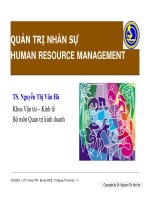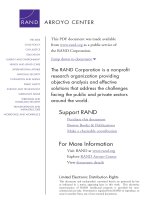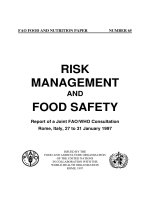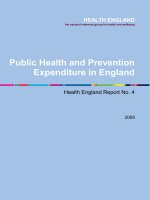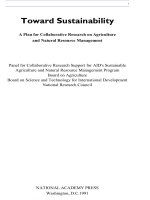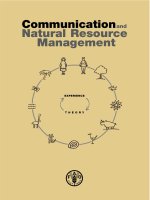Home Economics Health and Food Technology Resource Management docx
Bạn đang xem bản rút gọn của tài liệu. Xem và tải ngay bản đầy đủ của tài liệu tại đây (1.1 MB, 170 trang )
Home Economics
Health and Food Technology
Resource Management
[HIGHER]
abc
Acknowledgement
Learning and Teaching Scotland gratefully acknowledge this contribution to the National
Qualifications support programme for Home Economics.
First published 2005
© Learning and Teaching Scotland 2005
This publication may be reproduced in whole or in part for educational purposes by
educational establishments in Scotland provided that no profit accrues at any stage.
ISBN 1 84399 088 1
The Scottish Qualifications Authority regularly reviews
the arrangements for National Qualifications. Users of all
NQ support materials, whether published by LT Scotland
or others, are reminded that it is their responsibility to
check that the support materials correspond to the
requirements of the current arrangements.
© Copyright Learning and Teaching Scotland
HEALTH AND FOOD TECHNOLOGY: RESOURCE MANAGEMENT (H) 3
CONTENTS
Section 1: Functions and sources of nutrients 5
Section 2: Water and non-starch polysaccharides (NSP) 17
Section 3: The body’s absorption of calcium and iron 19
Section 4: Interrelationship of dietary food sources 21
Section 5: Effects of storage on nutrients 23
Section 6: Effects of preparation and cooking on nutrients 25
Section 7: Prevention of dietary diseases 31
Section 8: The use of dietary reference values (DRVs) 47
Section 9: Current dietary advice: the Scottish dietary targets 75
Section 10: Causes of food poisoning 101
Section 11: Causes of contamination and cross-contamination 119
Section 12: Product development strategy 125
Section 13: Market research 133
Section 14: Sensory testing 137
Section 15: Functional properties of food 147
Section 16: Factors affecting finished products 161
© Copyright Learning and Teaching Scotland
HEALTH AND FOOD TECHNOLOGY: RESOURCE MANAGEMENT (H)
4
© Copyright Learning and Teaching Scotland
FUNCTIONS AND SOURCES OF NUTRIENTS
HEALTH AND FOOD TECHNOLOGY: RESOURCE MANAGEMENT (H) 5
SECTION 1
Functions and sources of nutrients
Elaboration
• Protein
• Fats – saturated, unsaturated, trans-fatty acids
• Carbohydrates
• Vitamins A, B complex, C, D and E
• Minerals – calcium, phosphorus, iron, sodium
It is important for good health to eat a balanced diet. A balanced diet
provides all the necessary nutrients in the correct proportions and
quantities to meet our needs. One way to follow a balanced diet is to
make sure we eat a variety of foods which supply a range of nutrients.
Protein
• Proteins are made up of amino acids.
• Proteins that contain all the essential amino acids are called high
biological value (HBV) proteins.
• Proteins that lack one or more of the essential amino acids are called
low biological value (LBV) proteins.
Functions Sources
Proteins are essential to life. All High biological value (HBV) proteins:
living cells are built and replaced • These are found mainly in animal
by protein molecules. The main sources such as meat, cheese,
value of protein is in: fish, milk, eggs.
• Growth of new cells • The plant food soya beans contain
• Repair of cells HBV protein.
• Maintenance of the body cells.
The secondary value of protein: Low biological value (LBV) proteins:
• Excess protein will provide the • These are found mainly in plant
body with energy, once it has food such as
been used for its main purpose of – cereals, e.g. wheat, rice, oats
growth, repair and maintenance. – pulses, e.g. peas, beans, lentils
– some nuts, quorn.
© Copyright Learning and Teaching Scotland
FUNCTIONS AND SOURCES OF NUTRIENTS
HEALTH AND FOOD TECHNOLOGY: RESOURCE MANAGEMENT (H)
6
Fats
• The term ‘fat’ includes both fats (solid at room temperature) and oils
(liquid at room temperature).
• Fat is present in food either as ‘visible’ or ‘invisible’ fat
– Visible fat is easy to detect in food, e.g. fat on meat, butter,
margarine, lard, cooking oil.
– Invisible fat is a constituent part of food and is difficult to detect,
e.g. fat in pastry, cakes, biscuits.
Functions of fats are to:
• Provide a concentrated source of energy
• Provide essential fatty acids
• Provide a source of fat-soluble vitamins A, D, E and K
• Surround and protect certain vital organs such as the kidneys
• Form an insulating layer underneath the skin and so to help maintain
body temperature
• Provide a feeling of fullness (satiety) through consumption of foods
containing fat
• Support the structure of all body cells.
Fats can be classified into saturated fats and unsaturated fats.
Saturated fats
Important points Sources
• Fats which are solid at room Mainly of animal origin
temperature are mostly made of • Meat and its products, e.g. pies,
saturated fatty acids. sausages, lard, suet
• A diet high in saturated fats tends • Fats, e.g. butter, hard margarine,
to raise blood cholesterol levels some blended cooking oils
(particularly the low-density • Milk and dairy products, e.g. butter,
lipoprotein – LDL, the ‘bad’ whole milk, cheese, cream, eggs
cholesterol) in some people, so But also
increasing the risk of heart disease. • Coconut oil and palm oil which are
• The LDL tends to stick to artery used to make biscuits, pastry, cakes
walls, increasing the risk of blood
clots and blockage of the artery.
• Certain cancers such as bowel and
breast cancer have been linked
with high intakes of saturated fats.
© Copyright Learning and Teaching Scotland
FUNCTIONS AND SOURCES OF NUTRIENTS
HEALTH AND FOOD TECHNOLOGY: RESOURCE MANAGEMENT (H) 7
Unsaturated fats
Important points Sources
Monounsaturated fats
• Monounsaturated fats remain liquid at • Olive oil
room temperature, but start to solidify • Rape seed oil
when chilled • Avocados
• Monounsaturated fats reduce the bad • Nuts
LDL cholesterol. They also maintain or
slightly increase the good high-density
lipoprotein (HDL) cholesterol.
• HDL cholesterol helps to ferry the
cholesterol away from the arteries to the
liver where it is broken down into bile.
Polyunsaturated fats
• Polyunsaturated fats usually remain • Oily fish, e.g. mackerel and
liquid at both room temperature and sardines
cold temperatures. • Pure vegetable oils, e.g.
• Polyunsaturates help to bring down sunflower, soya
blood cholesterol levels. • Nuts and seeds
• There are specific polyunsaturates which
are vital for health and cannot be made
in the body. These are called essential
fatty acids (EFAs) and must be
obtained from food.
Essential fatty acids
The two main EFAs are
• Omega 3 (or linolenic acid) Omega 3
Omega 3 reduces the risk of blood clots • Oily fish – mackerel, pilchards,
forming, so reducing the risk of a heart sardines, herrings, trout
attack. It may also reduce the incidence
of inflammatory diseases, such as
rheumatoid arthritis.
• Omega 6 (or linoleic acid) Omega 6
These tend to decrease bad cholesterol, • Polyunsaturated margarine
but too much may also decrease good • Corn, sunflower and
cholesterol levels. soya bean oils
Both Omega 3 and 6 are needed for
brain development in babies. Humans
make special linolenic and linoleic acids
in breast milk. This is one of the reasons
why human breast milk is best for babies.
cont’d on the next page
© Copyright Learning and Teaching Scotland
FUNCTIONS AND SOURCES OF NUTRIENTS
HEALTH AND FOOD TECHNOLOGY: RESOURCE MANAGEMENT (H)
8
• Another type of polyunsaturated fat • Hard margarine
is called trans-fatty acids. Trans-fatty • Biscuits and cakes
acids are polyunsaturated fats • Commercially fried foods,
artificially hardened by adding e.g. French fries from fast-food
extra hydrogen. chains
They cause an increased risk of heart • Packaged snacks
disease and rheumatoid arthritis and • Any food label that indicates
may be linked to some cancers. hydrogenated or partially
Trans-fatty acids increase blood levels hydrogenated fats/oils
of bad cholesterol and may reduce
levels of good cholesterol.
Trans-fatty acids are not listed on food
ingredients, but hydrogenated or
partially hydrogenated oils are listed.
Carbohydrates
The functions of carbohydrates are:
• To supply energy for all activities
• To supply energy to maintain normal body temperature
• To supply indigestible fibrous material (NSP: Non Starch
Polysaccharides) to aid digestion
• Important in the structure of cells.
Carbohydrates can be subdivided into three main groups:
1. Monosaccharides (sugars)
2. Disaccharides (sugars)
3. Polysaccharides (starches)
Sugars can also be classified as:
• Intrinsic sugars – those that form part of the cell structure of plants
(for example fruits)
• Extrinsic sugars – not part of the cell structure of plants. They
include non-milk extrinsic sugars (NME sugars), for example refined
sugar, sugar added to foods, extracted sugars in honey and fruit juice.
© Copyright Learning and Teaching Scotland
FUNCTIONS AND SOURCES OF NUTRIENTS
HEALTH AND FOOD TECHNOLOGY: RESOURCE MANAGEMENT (H) 9
Important points Sources
1. Monosaccharides
Monosaccharides or simple sugars are
single-unit carbohydrates.There are three
main monosaccharides:
• Glucose Fruit, vegetables, e.g. onions,
beetroot, available in powder,
liquid or tablet form honey
• Fructose (often called ‘fruit sugar’) Fruit and vegetables, honey
• Galactose Milk
2. Disaccharides
These are double sugars made up of two
monosaccharides joined together.
The three main disaccharides are:
• Sucrose
Used in cookery and obtained by Refined sugar cane or beet.
refining sugar cane or beet. Sucrose is Some fruit and vegetables.
formed from one unit of glucose and one
unit of fructose.
• Lactose
Found in the milk of mammals to supply Milk
the infant with a source of energy. It is not
as sweet as sucrose. Lactose is formed from
one unit of glucose and one unit of
galactose
• Maltose
Sometimes called ‘malt sugar’, it is found Germinating cereals, e.g. barley
in cereals where it is formed during
germination. Maltose is formed from two
units of glucose.
3. Polysaccharides
These are called starches or complex
carbohydrates. They consist of chains of
monosaccharides.
The main polysaccharides are:
• Starch Bread, flour, potatoes, cakes
Formed from many glucose units
joined together like links in a chain.
• Non-starch Polysaccharides (NSP) Wholegrain cereals – oats,
These are a form of polysaccharides. wheat, rice, wholemeal bread.
Skins of fruit and vegetables
© Copyright Learning and Teaching Scotland
FUNCTIONS AND SOURCES OF NUTRIENTS
HEALTH AND FOOD TECHNOLOGY: RESOURCE MANAGEMENT (H)
10
Starches
It is recommended that we should get most of our energy from starch or
complex carbohydrate foods rather than sugar. There are a number of
reasons for this.
• Starch foods are good sources of other nutrients. Examples include
potatoes, which are also a source of vitamin C; and bread, which is
also a source of protein, calcium and iron. Sugar is often described as
‘empty calories’ since it provides energy but no other nutrients.
• Starch foods provide bulk with few calories. Most of these foods
provide substantial amounts of water and NSP. This means that they
are filling, without being a concentrated source of energy.
• They do not encourage tooth decay, as bacteria in the mouth do not
like starches. On the other hand, sugar provides food for acid-
producing bacteria on the surface of the teeth and this acid damages
teeth.
• They are generally inexpensive foods. For example, bread and
breakfast cereals are inexpensive and are fortified with vitamins and
minerals.
© Copyright Learning and Teaching Scotland
FUNCTIONS AND SOURCES OF NUTRIENTS
HEALTH AND FOOD TECHNOLOGY: RESOURCE MANAGEMENT (H) 11
Vitamins
Although vitamins are only required in small amounts, each is essential
to general good health. Vitamins are classified according to whether
they are soluble in fat or water.
Vitamin A
This is a fat-soluble vitamin. Carotene (the plant source of vitamin A) is
converted to vitamin A in the small intestine.
Functions Sources
• Required to make visual purple (a red Animal sources (as retinol)
photopigment), which assists with good • Milk, cheese, butter, eggs
vision – particularly in dim light • Oily fish – sardines, herring,
• Required to keep the mucous pilchards, fish liver oils
membranes in the eyes, lungs, throat • Added to margarine by law
and digestive tract moist and free from Plant sources (as carotene)
infection • Green vegetables – spinach,
• One of the antioxidant vitamins that watercress, parsley, cabbage
helps to prevent cancer and heart • Orange and red-coloured fruit
disease and vegetables – carrots,
• Required for the maintenance and tomatoes, apricots
health of the skin
• Required for the normal growth of
children
© Copyright Learning and Teaching Scotland
FUNCTIONS AND SOURCES OF NUTRIENTS
HEALTH AND FOOD TECHNOLOGY: RESOURCE MANAGEMENT (H)
12
Vitamin B complex
This is a water-soluble vitamin. There are many types of vitamin B within
this group.
Functions Sources
Vitamin B1 (thiamin )
• Essential for the release of energy from • White flour is fortified by law
carbohydrates • Fortified breakfast cereals
• Needed for growth and normal • Brown rice, wholemeal pasta
functioning of the nervous system • Liver, kidney
• Maintains muscle tone • Milk and eggs
• Required for the normal growth of
children and for general good health
Vitamin B2 (riboflavin)
• Essential for the release of energy from • Meat, liver, kidney
food, especially protein, carbohydrates • Milk and eggs
and fats • Green vegetables
• Essential for normal growth • Wholemeal bread
• Some is also manufactured by
bacteria in the intestine
Vitamin B3 (niacin)
• Essential for the release of energy from • Meat and meat products
food, especially carbohydrates • Poultry and fish
• Essential for healthy skin and nerves • Wholemeal bread and cereals
• Fortified breakfast cereals
• Pulses, nuts
• Some is also manufactured by
bacteria in the intestine
Vitamin B12
• Helps prevent certain forms of anaemia • All animal foods – meat, liver,
(pernicious anaemia) fish, cheese, milk, eggs
• Needed for the metabolism of amino • Fortified breakfast cereals
acids (protein)
• Protects the nervous system
Folic acid (folate)
• Essential for the formation of blood cells • Green leafy vegetables – brussels
• Helps protect against neural tube defects sprouts, broccoli
such as spina bifida in unborn babies. • Wholegrain cereals
Women are advised to eat folate-rich • Fortified breakfast cereals
foods before planning a pregnancy and • Dairy products
for the first 12 weeks of pregnancy • Peas, beans and lentils
• Required for the release of energy from • Oranges, bananas and grapefruit
food, especially protein
• Essential for normal growth
© Copyright Learning and Teaching Scotland
FUNCTIONS AND SOURCES OF NUTRIENTS
HEALTH AND FOOD TECHNOLOGY: RESOURCE MANAGEMENT (H) 13
Vitamin C
This is a water-soluble vitamin.
Functions Sources
• Must be present to help the absorption Rich sources
of iron and so helps prevent anaemia • Blackcurrants, rosehips, green
• One of the antioxidant vitamins that peppers, kiwi fruits
helps to prevent cancer and heart Good sources
disease • Citrus fruits – oranges, lemons,
• Required to make connective tissue grapefruit, limes
which binds body cells together • Strawberries
• Helps cuts and wounds to heal quicker • Cabbage, spinach, brussels
• Essential in the manufacture of blood sprouts, broccoli
and cell walls of blood vessels Reasonable sources
• Bean sprouts, peas, potatoes
Vitamin D
This is a fat-soluble vitamin.
Functions Sources
• Must be present so that calcium is • Main non-food source is the sun’s
absorbed ultra-violet rays reacting on the
• Essential in the intestine so that calcium skin. A substance under the skin
can be absorbed is converted to vitamin D which
• Acts with calcium and phosphorous to is then stored in the liver. The
form strong bones and teeth sun could supply all the body’s
• Promotes quicker healing of bone requirements for vitamin D.
fractures • Cod and halibut liver oils, oily
fish
• Added by law to margarine
• Egg yolk
• Fortified breakfast cereals
• Fortified infant milk
© Copyright Learning and Teaching Scotland
FUNCTIONS AND SOURCES OF NUTRIENTS
HEALTH AND FOOD TECHNOLOGY: RESOURCE MANAGEMENT (H)
14
Vitamin E
This is a fat-soluble vitamin.
Functions Sources
• A very effective antioxidant vitamin that • Vegetable oils, especially
helps to prevent certain cancers and sunflower seed oil
heart disease • Egg yolk
• Involved in the maintenance of cell • Wheat germ
membranes – protects polyunsaturated • Oatmeal
fatty acids from damage by free radicals • Peanuts
in the cell membranes in the body • Margarine
• Milk and milk products
• Liver and meat
• Leafy green vegetables, such as
lettuce, contain a small amount
Antioxidant vitamins
• Antioxidant vitamins, known as the ACE vitamins, have an important
effect on health. The ACE vitamins include vitamin A (and in
particular beta carotene – the vegetable source of vitamin A), vitamin
C and vitamin E.
• Antioxidant vitamins ward off free radicals which are a natural result
of the oxygen-using processes in the body, e.g. breathing, digestion.
• Left to their own devices, free radicals can form a chain reaction that
can cause serious damage to cells and contribute to heart disease and
cancers.
• Antioxidants form a defence system against the free radicals.
• Antioxidants occur naturally in a wide range of foods, including
– vitamin A – red and orange fruit and vegetables, e.g. carrots,
tomatoes, apricots and peaches
– vitamin C – citrus fruits, blackcurrants, kiwi fruit, green leafy
vegetables, e.g. broccoli, etc.
– vitamin E – vegetable oils, wholegrain cereals, green leafy
vegetables.
© Copyright Learning and Teaching Scotland
FUNCTIONS AND SOURCES OF NUTRIENTS
HEALTH AND FOOD TECHNOLOGY: RESOURCE MANAGEMENT (H) 15
The health benefits of antioxidants
• They safeguard long-term health
– by reducing the risk of chronic diseases, e.g. heart disease, a
variety of cancers, and disorders of the intestine caused by
increased numbers of free radicals
– by reducing damage to body cells and tissues.
• They maintain a healthy immune system
– by destroying free radicals which attack the body’s natural defence
system.
• They reduce the harmful oxidation of fats in the body
– by preventing free radicals oxidising polyunsaturated fatty acids in
foods and in cell membranes to give a substance which causes cell
damage
– by slowing the rate at which LDL cholesterol is deposited on artery
walls, thus reducing the risk of heart disease.
Fruit and vegetables are a source of antioxidants and will also provide
NSP. This will give additional benefits such as less constipation, bowel
cancer, less obesity and over consumption of foods high in sugar and fat.
© Copyright Learning and Teaching Scotland
FUNCTIONS AND SOURCES OF NUTRIENTS
HEALTH AND FOOD TECHNOLOGY: RESOURCE MANAGEMENT (H)
16
Minerals
Calcium
Function Sources
• With phosphorus it combines to make • Milk, cheese, yoghurt
calcium phosphate which is the chief • Fortified white flour and white
material that gives hardness and strength bread
to bones and teeth • Green leafy vegetables
• Helps blood to clot after an injury • Tinned fish with bones that can
• Required for the correct functioning of be eaten, such as salmon, sardines
muscles and nerves • Dried fruit
• Required for maintenance of bones and • Nuts and seeds
teeth
Phosphorus
Function Sources
• Works with calcium in the formation, Found in most natural foods –
development and maintenance of bones present as phosphate in all plant
and teeth and animal cells
• Essential for the production of energy • Milk, cheese, eggs
in the body by releasing energy from • Cereal products
the cells • Meat and meat products
• Fish
• Nuts
Iron
Function Sources
• Iron is a component of haemoglobin, • Red meat especially liver, kidney,
the substance which gives red blood corned beef
cells their colour • Fortified flour and bread
• Haemoglobin is required to transport • Green leafy vegetables
oxygen around the body to every cell • Dried fruit
so that we do not feel tired and • Pulse vegetables
eventually become anaemic • Cocoa, plain chocolate
• Needed to form red cells in the blood
Sodium
Function Sources
• Water balance – essential for maintaining • Table salt
the correct fluid balance of the body • Bacon
• Needed by cell walls so that nutrients in • Cheese
the blood can flow into body cells and • Some savoury snacks, e.g. crisps
waste products can flow out • Canned foods
• Required for correct muscle and nerve • Found naturally in some foods
activity – too low an intake can result in such as fish and meat
muscle cramps.
© Copyright Learning and Teaching Scotland
WATER AND NON-STARCH POLYSACCHARIDES (NSP)
HEALTH AND FOOD TECHNOLOGY: RESOURCE MANAGEMENT (H) 17
SECTION 2
Water and non-starch polysaccharides (NSP)
Functions of water Sources of water
• Water is vital to life – 70% of the human • Fruit and vegetables
body is water • Milk
• Required for all body fluids, e.g. • Meat
digestive juices, mucus, saliva, blood, • Tap water
sweat and urine • Bottled mineral water (still and
• Assists in the excretion of waste faeces carbonated)
by combining with NSP and so prevents
constipation
• Required as part of many metabolic
reactions, e.g. water is a major
constituent of the fluid which carries
nutrients to the cells
• Keeps linings of mucous membranes,
digestive tract and bronchial tubes moist
• Some nutrients need to dissolve in water
for proper absorption
• Helps regulate body temperature by
perspiration
• Lubricates joints and membranes
© Copyright Learning and Teaching Scotland
WATER AND NON-STARCH POLYSACCHARIDES (NSP)
HEALTH AND FOOD TECHNOLOGY: RESOURCE MANAGEMENT (H)
18
Functions of NSP Sources of NSP
• Aids the removal of waste products,
which could be harmful or toxic, from
the body
• Absorbs a lot of water ensuring that the
faeces are soft and bulky, enabling them
to pass along the intestine by means of
peristalsis
• Helps prevent various bowel disorders
including constipation, diverticular
disease, bowel cancer, and
haemorrhoids (piles)
There are two types of NSP:
(a) Soluble NSP Soluble NSP
This type of NSP is thought to slow • Oats
down the digestion and absorption of • Pulse vegetables – peas, beans
carbohydrates and so help to control and lentils
blood sugar levels – it is useful for • Most types of fruit and vegetables
diabetics
(b) Insoluble NSP Insoluble NSP
Insoluble NSP absorbs water and • Wholemeal bread and flour
increases in bulk, so helping the gut • Wholegrain breakfast cereals,
keep in good working order pasta and rice
• Fresh fruit and vegetables
© Copyright Learning and Teaching Scotland
ABSORPTION OF CALCIUM AND IRON
HEALTH AND FOOD TECHNOLOGY: RESOURCE MANAGEMENT (H) 19
SECTION 3
The body’s absorption of calcium and iron
Elaboration
Factors which assist calcium absorption:
• Vitamin D
• Lactose
• Protein
Factors which hinder calcium absorption:
• Lack of vitamin D
• Phytic acid
• Fibre (dietary)/NSP
• Fats
• Oxalic acid
Calcium absorption
Factors which assist calcium Factors which hinder calcium
absorption absorption
Vitamin D Lack of vitamin D
• Vitamin D controls absorption • Without vitamin D less calcium will be
of calcium so there must be a absorbed and this deficit may adversely
good supply in the diet affect the strength of bones and teeth
• Without vitamin D we cannot
make use of the calcium in Phytic acid
food • Phytic acid is found in wholegrain cereal
foods and combines with calcium in a
Lactose form that prevents calcium being absorbed
• This is a sugar present in
milk and increases calcium NSP
absorption during digestion • NSP cannot be digested in the human
digestive system as the NSP and calcium bind
Protein together. Much of the calcium in fibrous
• The amino acids formed foods is made unavailable to the body
from protein as a result of
digestion combine with Fats
calcium to form soluble • Fats, particularly saturated fatty acids,
salts and these salts are form insoluble soaps with calcium which
very readily absorbed cannot be absorbed by the body
Oxalic acid
• Oxalic acid, which is particularly high in
rhubarb and spinach, also interferes with
calcium absorption
© Copyright Learning and Teaching Scotland
ABSORPTION OF CALCIUM AND IRON
HEALTH AND FOOD TECHNOLOGY: RESOURCE MANAGEMENT (H)
20
Iron absorption
Elaboration
Factors which assist iron absorption:
• Vitamin C
Factors which hinder iron absorption:
• Lack of vitamin C
• Fibre (dietary)/NSP
• Phytic acid
Factors which assist iron absorption Factors which hinder iron absorption
Vitamin C Lack of vitamin C
• Vitamin C is needed to change the • If vitamin C is lacking in a diet, the
iron into a form that is more easily iron in food will not be able to be
absorbed – from its ferric state to a changed from its ferric (non-haem)
ferrous state state into the easily absorbed (haem)
• Most of the iron in food is in a ferrous state
ferric state and cannot be absorbed
and must be changed to ferrous NSP
iron to help absorption. • Too much indigestible NSP in leafy
vegetables and fresh fruit can bind
with iron and therefore not allow it to
be absorbed into the blood stream.
• Phytates found in food containing NSP
will remove iron from the body
• Phytates form insoluble complexes
with iron in the small intestine which
then inhibits iron absorption
Phytic acid
• Phytic acid in wholegrain cereals binds
with iron to prevent absorption
© Copyright Learning and Teaching Scotland
INTERRELATIONSHIP OF DIETARY FOOD SOURCES
HEALTH AND FOOD TECHNOLOGY: RESOURCE MANAGEMENT (H) 21
SECTION 4
Interrelationship of dietary food sources
Elaboration
• Calcium, phosphorus and vitamin D
• ACE vitamins
• Iron, vitamin C and folic acid
• Vitamin B complex and carbohydrates
• Iron, fibre (dietary)/NSP and phytic acid
• Water and fibre (dietary)/NSP
Interrelationship of: calcium, phosphorus and vitamin D
• Calcium and phosphorus are both needed together for the formation
and maintenance of strong bones and teeth. Together they form
calcium phosphate which gives bones and teeth their hardness.
• Absorption of calcium is controlled by vitamin D. A diet lacking in
vitamin D results in poor calcium absorption and affects the formation
of strong bones and teeth.
• Without vitamin D we cannot make use of the calcium in food.
• If blood levels of calcium and phosphorus fall too low then the
hormone produced by the parathyroid gland removes these nutrients
from the bones and teeth and sends them back into the blood.
Interrelationship of: ACE vitamins
• The best-known antioxidants, which help to neutralise potentially
damaging free radicals in the body, are vitamins A, C and E.
• A diet high in ACE vitamins is thought to reduce the risk of coronary
heart disease.
• Vitamin E improves the activity of vitamin A in the body.
• Vitamin C helps the action of vitamin E in the body, e.g. after vitamin
E has been used by the body and is finished, vitamin C then works on
this vitamin E to recycle it.
Interrelationship of: iron, vitamin C and folic acid
• Depending on the food source of iron, about 10 per cent of the iron
which is eaten is actually absorbed by the body. Iron in our food is
ferric iron, and cannot be absorbed until it is changed to ferrous iron.
© Copyright Learning and Teaching Scotland
INTERRELATIONSHIP OF DIETARY FOOD SOURCES
HEALTH AND FOOD TECHNOLOGY: RESOURCE MANAGEMENT (H)
22
• Vitamin C is required to change iron into its more easily absorbed
form – ferrous iron – and thus ensures an adequate supply of red
blood cells.
• Folic acid also improves the red blood cell count – if iron is lacking
then folic acid can supplement the supply.
• Folic acid can also help prevent megaloblastic anaemia if the iron
absorption is poor
Interrelationship of: vitamin B complex and carbohydrate
• Vitamin B complex acts as a link in a complex chain of chemical
reactions which release energy from carbohydrates.
• The B-complex vitamins have a role in the release of energy from
food so that it can be used by the body.
• The release of energy from carbohydrates requires adequate supplies
of B-complex vitamins.
• If more energy is needed by the body, e.g. for a sports person, then
more vitamin B complex is required to release the energy.
• Vitamin B1 (thiamine) helps release energy from glucose.
• Vitamin B2 (riboflavin) and vitamin B3 (niacin) help release energy
from food.
Interrelationship of: iron, NSP and phytic acid
• Too much indigestible NSP in leafy vegetables and fresh fruit can bind
with iron and therefore not allow it to be absorbed into the
bloodstream.
• Phytates found in food containing NSP will remove iron from the
body in waste materials.
• Phytates form insoluble complexes with iron in the small intestine
which then inhibits iron absorption.
• Phytic acid found in wholegrain cereal foods prevents the absorption
of iron from foods.
Interrelationship of: water and NSP
• NSP absorbs water in the gut. The bulk and softness of the waste
matter is affected by this absorption of the water.
• If there is no NSP in the waste matter, no water is absorbed into it and
the waste matter is then difficult to get rid of from the body
(constipation).
• If there is plenty of NSP and the waste matter absorbs water, it
becomes bulkier, softer and much easier to pass out of the body.
• NSP is of great importance in the diet as it absorbs a lot of water, and
binds the other food residues to itself. This ensures that the faeces
are soft and bulky and so can pass out of the body easily and quickly.
© Copyright Learning and Teaching Scotland
EFFECTS OF STORAGE OF NUTRIENTS
HEALTH AND FOOD TECHNOLOGY: RESOURCE MANAGEMENT (H) 23
Effects of storage of nutrients
Elaboration
• Deterioration and rancidity of fats when exposed to air
• Deterioration and oxidation of vitamins
• Suitable storage methods to reduce loss of nutrients
Nutrient Effect of storage
Fats Deterioration and rancidity of fats when exposed to air
• Exposure to air leads to gradual deterioration of fat due
to rancidity
• Fat may become rancid due to:
Oxidation
– in oxidation oxygen is absorbed by the fat molecules
and reacts with these to produce substances which
give the fat an unpleasant flavour and colour
– oxidation is accelerated by light, by the impurities in
fat, by enzymes and by the presence of many
polyunsaturated fatty acids.
The enzyme lipase
– lipase breaks down the fat molecules and ‘off’
flavours and odours develop because of the fatty
acids in the food.
SECTION 5
© Copyright Learning and Teaching Scotland
EFFECTS OF STORAGE OF NUTRIENTS
HEALTH AND FOOD TECHNOLOGY: RESOURCE MANAGEMENT (H)
24
Vitamins Deterioration and Suitable storage methods to
oxidation of vitamins reduce loss
A Vitamin A is found in fatty To reduce loss, store in a fridge,
foods and may be lost during package foods, or store in dark
storage as a result of containers away from light
oxidation or exposure to light
Vitamin B complex
Vitamin B1 Exposure to sunlight/ UV light Store away from light
(thiamin) reduces thiamine content
Vitamin B2 This vitamin deteriorates Store away from sunlight in dark
(riboflavin) quickly with exposure to UV conditions
light Avoid foods stored for a length
of time in a brightly illuminated
supermarket display cabinet
Vitamin B3 Some loss by oxidation Avoid storage if possible
(nicotinic
acid)
Vitamin C Do not store for a long time as Buy as fresh as possible, as long-
vitamin C is oxidised by term storage causes deterioration
exposure to air. The vitamin C of vitamin C
content is reduced by oxidation
Store in a refrigerator as low
Exposure to air leads to changes temperature slows down
to the chemical structure of oxidation of vitamin C, e.g. put
vitamin C so that it cannot be green leafy vegetables in the
used by the body. vegetable or salad drawer in the
refrigerator
Bruised fruits and vegetables Store in the absence of light to
will have lost more vitamin C avoid loss of vitamin C, e.g.
by enzyme action and oxidation store root vegetables in a cool
dark place, away from heat,
daylight and air
Avoid bruising or damage prior
to storage as this will lead to
destruction of vitamin C
Avoid buying ready prepared
produce as these are more likely
to have suffered nutrient loss
because of advance preparation
and then storage. Frozen
vegetables have a higher
vitamin C content, because they
are frozen quickly so that the
vitamin is preserved
© Copyright Learning and Teaching Scotland
EFFECTS OF PREPARATION AND COOKING ON NUTRIENTS
HEALTH AND FOOD TECHNOLOGY: RESOURCE MANAGEMENT (H) 25
SECTION 6
Effects of preparation and cooking on nutrients
Elaboration
• Loss of vitamin B complex in milling process
• Preparation of fats to assist digestion
• Effects of preparation methods on vitamin C
Effects of preparation on nutrients
Nutrient Effect of preparation
Vitamin B Loss of Vitamin B complex in milling process
Complex • The B-complex vitamins are contained in the bran (outer
husk) of a cereal grain. When the wheat grain is milled to
produce white flour these parts are removed along with the
vitamin B complex
• White rice is usually ‘polished’ to free it from bran. Vitamin
B1 is removed with the bran. If rice is the staple diet as in
Far Eastern countries, then the disease beri-beri may result
Fats Preparation of fats to assist digestion
• A high concentration of fat in some food, e.g. cheese,
makes it difficult to digest
• Exposing more of the surfaces of the food to the digestive
juices by dividing finely, e.g. grating, chopping and slicing,
enables the fat to be more easily digested
• Combining with a starchy food, e.g. cheese with potatoes
or macaroni, will help absorb the fat and so make the food
more digestible
Vitamin C Effects of preparation methods on vitamin C
• Avoid soaking as vitamin C is water soluble and will leach
out into the water and will be lost unless the water is used
as a gravy
• Prepare as needed because vitamin C will be lost through
oxidation if the fruit and vegetables are prepared in
advance
• An enzyme in the vegetables called oxidase is activated by
chopping and cutting. As this enzyme activity will destroy
cont’d on the next page
© Copyright Learning and Teaching Scotland



